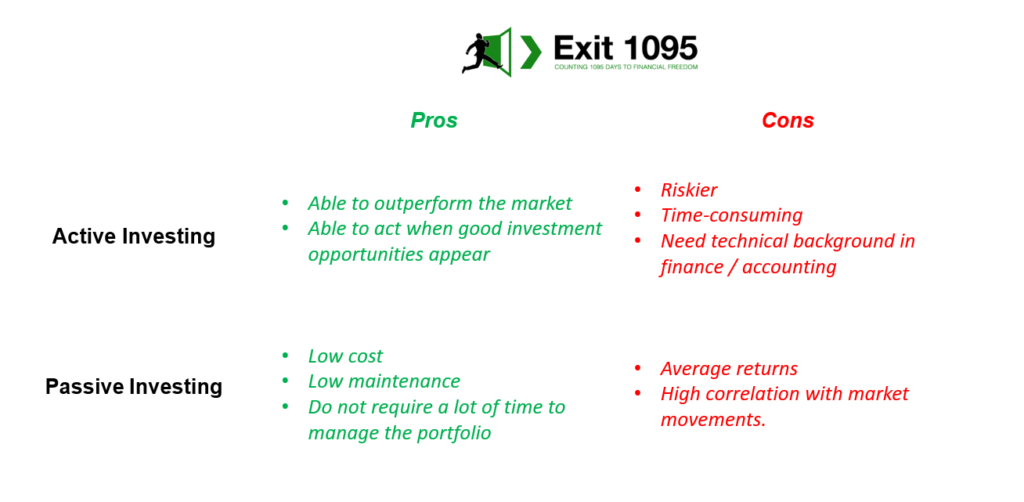Introduction
This post is probably a continuation of my previous post about my FIRE investing approach (read it here). I highly recommend reading it in advance to better assimilate this content.
There have been many discussions on which approach is the best when investing: active or passive investing. Each method has its advantages and drawbacks, and, in my opinion, the best choice depends on the investor profile.
In summary, I recommend active investing if you have plenty of time to study and research and like to deal with accounting principles. You can find exceptional investment opportunities if you have good evaluation skills and assessment frameworks in place.
On the other hand, if you don’t have too much time to review income statements and balance sheets, I recommend sticking to Passive Investing. There are multiple low-cost alternatives today that provide exposure to different markets and asset classes.
Keep reading for a detailed review of active and passive investing.
My first investments – my evolution as an investor
I have always been a fan of the stock market. I remember when I was a kid, I watched the news and was fascinated with the graphs and numbers shown on the TV Screen.
During my adolescence, I tried to understand why the prices were going up and down like a rollercoaster but could not figure it out.
When I had my first savings in my account, I decided that it was time to give a go at investing. Allured by the dream of becoming rich quickly, I made a couple of day-trade and swing-trade operations, losing a little money.
If you don’t know, day-trade is an operation where you buy and sell a stock (or any other asset) on the same day. The swing trade goes a little bit longer for days or weeks. It did not take too many trades to understand that what I was doing was actually betting.
I know that this is a little controversial, and some people believe that there is a considerable technique behind these two methods. I understand where they are coming from. Both methods have risk management principles, but I still don’t think they are solid enough to put my money in.
After reading and researching a lot, I finally found the value-investing methodology (see my post about it). In my opinion, it has a robust background and fits with my investor profile and that is why I like to implement it. However, value investing is an active investment strategy that requires dedication, knowledge, and time.
Given that I have been very busy with work and other parallel projects, I have decided to increase my portfolio allocation with passive investment options, such as ETFs. They suit my current requirements and might be a good option in the long term.
Active x Passive Investing
Active Investing
By definition, active investing is a strategy that involves an individual buy and selling an asset seeking profits. These investors are trying to exploit market inefficiencies (misprices) by leveraging their knowledge. The transactions are based on the investor’s assessment and, usually, he/she is actively trying to beat a market index.
For example, if your portfolio is based in Australia, you are “competing” against the ASX200 index. The ASX 200 index is the most recognised Australian market benchmark and comprises the 200 largest companies by market capitalisation (you can find its detailed composition in this link).

If you are based in the US, you are probably competing against the SP500 (see this link for further details about the SP500 index).
Active investing requires a significant level of effort and understanding around financial markets, finance, accounting, and statistics. Some people even take this as a full-time job and are passionate about it. To be successful, the investor must assess the security that he/she wants to buy and undertake a detailed review to check the feasibility of the investment.
This includes due diligence of the business, market opportunities and trends, competition, financial conditions, and so on.
It can be intense work, and the most successful people in active investing are the ones that can assimilate and consolidate a wide variety of different information and precisely assess the intrinsic value of a security.
Passive Investing
Passive investing, on the other hand, requires less technique and action. It usually involves buying a security that mimics one benchmark and hold it for the long term.
In this context, the famous Exchange Traded Funds (ETFs) have become very popular over the last decade. Investopedia defines ETF as a “type of security that tracks an index, sector, commodity, or other asset, but which can be purchased or sold on a stock exchange the same way a regular stock can.”
For example, you can have exposure to the ASX index by buying the following ETFs:
- ASX:A200 (BetaShares Australia 200 ETF)
- ASX: IOZ (iShares Core S&P/ASX 200 ETF)
- ASX:MVW (iShares Core S&P/ASX 200 ETF)
- ASX:STW (SPDR S&P/ASX 200 ETF)
- ASX:VAS (Vanguard Australian Shares Index ETF)
They have high liquidity, which means that it is very easy to buy and sell each of them in the market. One of the most significant advantages of ETFs is their low cost. Their annual fees are around 0.1% (it varies in accordance with each issuer).
Once you buy the asset, there is no real need to actively monitor it, and that is why we call it “passive” investing.
Pros and Cons
I summarised in the table below some of the pros and cons for each approach.

What should you apply to your FIRE Portfolio – active or passive investing?
Well, I think this depends on your profile and the amount of money and time you have.
Are you a person that is keen on financial markets and is willing to spend time researching about them? If yes, active investing is for you.
Do you have other priorities and don’t care too much about accounting statements? Stick to passive investing.
Personally, I use a bit of both. I used to spend a lot of time researching and reading about companies, derivatives, and potential opportunities.
During the COVID-19 crash in the early months of 2020, I bought a significant number of shares that are up 60-100% today. I had the courage to go into the market while everyone was selling their assets because I had studied and monitored the landscape for good opportunities.
However, after some time, I concluded that markets are an excellent way to preserve your wealth, not multiply them. I am not saying that you will not become rich by investing. In fact, you can reach your goals in the long term if you keep consistency in your investments. The problem (for me) is the timeline. I am not willing to stay in the corporate world for decades to achieve my FIRE savings.
That is why I’ve been reviewing my investment strategy and increasing my portfolio allocation in passive instruments (see my FIRE portfolio post). They require significantly less time commitment and still provide me with reasonable returns and dividends. I am using my extra time to explore opportunities in the digital world and plan my next steps.
Conclusion
The financial markets are an incredible tool to help you with your FIRE plans. There are currently multiple instruments that can help you generate passive income via different asset classes, such as real estate, stocks, and bonds.
The choice of a passive or active investing strategy depends on your profile and how much time are you willing to spend managing your portfolio.
I think the blended approach is the best. However, I’ve been concentrating on passive strategies over the last few months since my focus is on other goals, such as growing this blog.
This does not necessarily mean that I won’t be actively looking for opportunities in the future and ultimately left active investing. I enjoy the process, but now it is time for other priorities.
What about you? Do you prefer active or passive investing?
Speak (write) again soon!




